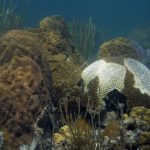Warm ocean water can be a killer for coral reefs, and AOML recently developed a new inexpensive sensor to drastically improve our ability to measure and monitor changing temperatures on reefs at an unprecedented scale. The low cost sea temperature sensor, known as InSituSea, costs roughly $10 in parts to produce while providing high accuracy (0.05-0.1 C) in measurement. With a production cost that is 10% of an off-the-shelf temperature sensor, colleagues have expressed strong interest in deploying the InSituSea sea temperature sensor at coral reefs around the world.
These sensors will not only be able to provide microhabitat sea temperature fluctuations at coral reef areas, but will provide environmental context to the study of coral bleaching, which is triggered by prolonged exposure to warm ocean waters over a period of days. Current global sea surface temperatures are monitored via satellite, and the expanded global observations offered by InSituSea could provide important comparison between ocean surface temperatures and the temperature at deeper regions where corals live.
AOML was prompted to develop the sensor based on the need to observe temperature variations at multiple locations at reefs, allowing scientists to observe changes at the microhabitat scale. With larger reefs measuring meters tall by tens of meters wide, temperature can vary by several degrees from the top to the bottom of a reef, as well as near shore versus ocean sides of a reef landscape. Observing small-scale fluctuations in temperature along many points at a reef will allow scientists to more discretely understand why some species or colonies of coral become bleached while others do not; it will also provide broader interpretation and validation for satellite measured sea temperature readings.

InSituSea sensor deployed at a deep water site for a field test. Image credit: NOAA
AOML is currently testing the sensors and deployed several in November at depths up to 110′ for about two months, measuring sea temperature every 10 minutes. The sensors can run up to five months using two AA batteries. In the near future, the sensors will have the capability for data transfer underwater via infrared communication. Other sensors (e.g. pressure, light, conductivity) will be added to the InSituSea unit in future tests. The data collected is embedded within a microchip so that data retrieval in the event of a flooded sensor can still be achieved. Once operational, initial deployments are planned to support on-going AOML coral research through the Coral Reef Early Warning System network and elsewhere under a broad program in collaboration with the global coral reef monitoring organization, ReefCheck (www.reefcheck.org).









